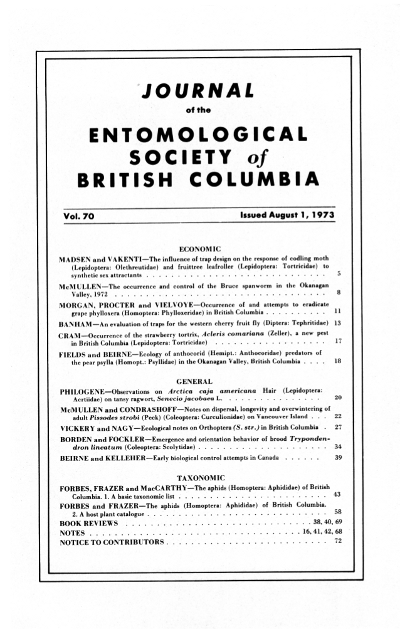Ecology of anthocorid (Hemipt.: Anthocoridae) predators of the pear psylla (Homopt.: Psyllidae) in the Okanagan Valley, British Columbia
Keywords:
Homoptera, Psyllidae, Hemipteral AnthocoridaeAbstract
The supposition is not valid that the disappearance of the native <i>Anthocoris melanocerus</i> from pear orchards late in the summer is because of competitive displacement by the introduced <i>A. nemoralis</i>. It is because <i>A. melanocerus</i> migrates to where prey are most abundant whereas <i>A. nemoralis</i> remains on pear. <i>A. melanocerus</i> is concentrated on willows in the spring, moves to pear when <i>Psylla pyricola</i> becomes abundant, and moves to cottonwood when aphids on it become abundant and the numbers of <i>P. pyricola</i> on pear have become low.References
DeBach, P. 1966. The competitive displacement and coexistence principles. Ann. Re v. Ent. 11:183-2 12
DeBach, P. and R.A. Sundby. 1963. Competitive displacement between ecological homologues. Hilgardia 34:105-166.
McMullen, R.D. 1971. Psylla pyricola Forster, pear psylla (Hemiptera: Psyllidae). In Biological Control Programmes against Insects and Weeds in Canada 1959-1968. Commonwealth Inst. Biol. Cont. Tech. Comm. 4:33-38.
McMullen, R.D. and C. Jong. 1967. New records and discussions of the pear psylla, Psylla pyricola Forster, in British Columbia. J. Ent . Soc. Br. Columb. 64:35-40.
Turnbull, A.L. and D.A. Chant. 1961. The practice and theory of biological control in Canada. Can. J. Zoo I. 39:677-753.
Downloads
Published
Issue
Section
License
Authors who publish with the Journal of the Entomological Society of British Columbia agree to the following terms:
-Authors retain copyright and grant the journal right of first publication with the work simultaneously licensed under a Creative Commons Attribution License that allows others to share the work with an acknowledgement of the work's authorship and initial publication in this journal.
-Authors are able to enter into separate, additional contractual arrangements for the non-exclusive distribution of the journal's published version of the work (e.g., post it to an institutional repository or publish it in a book), with an acknowledgement of its initial publication in this journal.
-Authors are permitted and encouraged to post their work online (e.g., in institutional repositories or on their website) prior to and during the submission process, as it can lead to productive exchanges, as well as earlier and greater citation of published work (See The Effect of Open Access).


